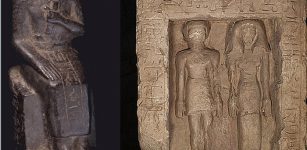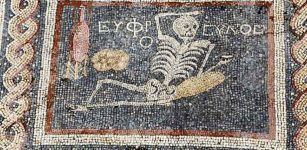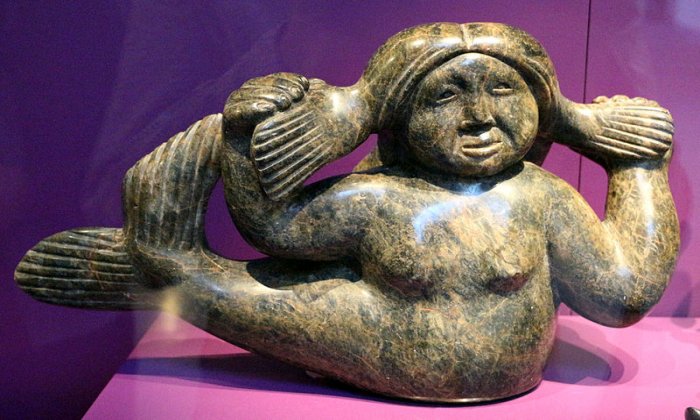Power Of Water In Beliefs Of Ancient Cultures
A. Sutherland - AncientPages.com - People have observed the water and its powers over the centuries and created related myths and legends.
The sea symbolizes the water of the "sea womb," giving birth to the earth and all that lived on it. 'To return to the sea' is 'to return to the mother,' that is, to die. All life arose once in the ocean, reflected in the creation myths of many ancient cultures.
Credit: Adobe Stock - kharchenkoirina
Water has been credited with purification and healing effects. One of many water places associated with healing is the Chalice Well in Glastonbury, England, where people have been using the spring since 3000 BC, glorifying these mineral-rich waters for their healing powers.
In the Vedas, water is "the most maternal" (mâtritamâh). In the beginning, everything was like a sea without light. In India, this element is generally regarded as the preserver of life, circulating throughout nature as rain. The Chinese consider water to be the residence of the dragon because all life comes from water.
Katsushika Hokusai: The Great Wave Off the Coast of Kanagawa. Public Domain
The sea is also a symbol of the unconscious. Many gods, spirits, and monsters are associated with the sea and natural phenomena such as tsunamis and whirlpools.
Deep water represents death and the supernatural. Poseidon's daughter Charybdis was changed into a sea animal and was most likely the personification of a dangerous whirlpool. Sailors who came too close to her risked dying.
Carl Jung (1875 -1961) once said about the sea and the unconscious. "The sea is the favorite symbol for the unconscious, the mother of all living." Christian baptism symbolizes the cleansing and washing of sin. In Hinduism, water is used for bathing and purifying god images in rites.
Poseidon (in Roman: Neptunus) had the power to control all the seas, but he also had a hot temper. He was highly respected by sailors and others who praised him in the hope of keeping this god happy. It guarantees smooth waters and a safe sea journey.
In Inuit mythology, Sedna was the goddess of the sea and the protector of marine animals. She ruled over the underworld of the Inuit. The fishermen worshiped her to make sure of a good catch.
Another god related to water was Nun ("water"), one of the oldest ancient Egyptian gods.
Depictions show him as a bearded man with blue-green skin resembling water. Nun was the god of the watery primeval void, also called "the primeval waters." In Aboriginal myth, the Wandjina Rain Spirit is the controller of the "Seasons" and the bringer of rain, which is crucial for life. Rain makes everything grow; the fruit, the trees, and the grass nourish animals, birds, and people.
The constant movements of the waves symbolize stability, change, joy, or sorrow; tide waves were linked with destruction and re-birth.
Sculpture of Sedna in the National Museum of Finland. Image credit: Sailko - CC BY 3.
In dreams, they are believed to represent fear of change. The river symbolizes fertility, irrigation of our planet, and running water and reflects the creativity of nature and time. It also indicates the border between two worlds – the Land of the Dead and the Land of the Living. In many cultures, some rivers can be sacred, and they can be river gods as well. Styx, for example, is a deity, the river of death, and one of the five central bodies of water that bordered Tartarus in Greek mythology.
In Hindu beliefs, the goddess Ganga represents the holy water of the river Ganges. Ganga and the river are worshipped as one, as this river plays a crucial role in the lives of the millions of Hindus in India. Hapi was the early Egyptian god of the Nile River. He used the Nile's annual floods to feed the land, bring fertility, and provide water, food and the annual flooding of the Nile River.
According to Hindu legends and Puranas, waterfalls (with healing and purifying powers) serve as a bathing place for gods and other celestial beings who visit them.
A waterfall means positive energy, the flow of life, happiness, vigor, and positive thoughts. A waterfall traditionally represents tranquility, peace, and contemplation. In the Shinto faith, waterfalls are sacred, and standing beneath them is said to purify one's soul. In a Shinto shrine, the faithful wash their hands and rinse their mouth with water from a long wooden spoon before praying, putting their hands close to their face, bowing, and meditating.
Flowing water also remains a fundamental element. The Shinto believers say that before diving in the bath or hot springs, purifying oneself by washing is an expression of ancestral body purification rites.
In China, lakes symbolize wisdom, receptiveness, and passivity. In Hinduism and Buddhism, temple lakes represent creation and the transition to the next life.
In many cultures, ponds, pools, and especially springs were believed to be abodes for water sprites, nymphs, or dangerous, prophetic demons.
In the past, water was sometimes a "judge." Women who were suspected of being witches were thrown into deep water. If they drowned, they were innocent. If they floated, however, they could be sentenced to witchcraft.
Water was used in witches' trials because it was believed that this "pure" element, like water, would reject those in league with the devil.
Written by – A. Sutherland - AncientPages.com Senior Staff Writer
Updated on January 3, 2024
Copyright © AncientPages.com All rights reserved. This material may not be published, broadcast, rewritten or redistributed in whole or part without the express written permission of AncientPages.com
Expand for referencesReferences:
Samual Noah Kramer, The Sumerians
Clayton, M. Hindu Mythology
Graves, R. The Greek Myths
More From Ancient Pages
-
 Controversial Prehistoric Structures That Resisted Water And Extreme Weather Conditions
Featured Stories | Jun 27, 2018
Controversial Prehistoric Structures That Resisted Water And Extreme Weather Conditions
Featured Stories | Jun 27, 2018 -
 Unraveling The Mystery Of The Celestial Matrix
Featured Stories | Sep 30, 2021
Unraveling The Mystery Of The Celestial Matrix
Featured Stories | Sep 30, 2021 -
 Homo Bodoensis Is A New Species Of Human Ancestors Who Lived Half A Million Years Ago
Archaeology | Nov 1, 2021
Homo Bodoensis Is A New Species Of Human Ancestors Who Lived Half A Million Years Ago
Archaeology | Nov 1, 2021 -
 Christian Church And Large House Unearthed In Ancient Laodicea, A Major Hub Of Christianity
Archaeology | Oct 31, 2020
Christian Church And Large House Unearthed In Ancient Laodicea, A Major Hub Of Christianity
Archaeology | Oct 31, 2020 -
 The Amarna Letters: Diplomatic Correspondence In Ancient Egypt
Artifacts | Apr 27, 2016
The Amarna Letters: Diplomatic Correspondence In Ancient Egypt
Artifacts | Apr 27, 2016 -
 Baba Yaga: Enigmatic, Powerful Archetypal Witch In Slavic Folklore
Slavic Mythology | May 16, 2016
Baba Yaga: Enigmatic, Powerful Archetypal Witch In Slavic Folklore
Slavic Mythology | May 16, 2016 -
 Excavation At Tell Edfu Reveals Early New Kingdom Complex
Archaeology | Jan 10, 2019
Excavation At Tell Edfu Reveals Early New Kingdom Complex
Archaeology | Jan 10, 2019 -
 Paris Point Zero And The Mysterious Statue Of Monsieur Legris
Featured Stories | Dec 4, 2018
Paris Point Zero And The Mysterious Statue Of Monsieur Legris
Featured Stories | Dec 4, 2018 -
 ‘Skeleton Mosaic’ – 2,400-Year-Old Scenes Depicted On Glass Artwork Found In Turkey
Archaeology | Apr 23, 2016
‘Skeleton Mosaic’ – 2,400-Year-Old Scenes Depicted On Glass Artwork Found In Turkey
Archaeology | Apr 23, 2016 -
 Ten Ancient Jugs And Shiloh May Reveal The Location Of The Biblical Tabernacle
Artifacts | Feb 6, 2019
Ten Ancient Jugs And Shiloh May Reveal The Location Of The Biblical Tabernacle
Artifacts | Feb 6, 2019 -
 Ancient Egyptian Temple, 30 Mummy Cards, 85 Tombs And Surveillance Points From The Era Of Ptolemy IIIs Discovered In Sohag
Archaeology | May 5, 2022
Ancient Egyptian Temple, 30 Mummy Cards, 85 Tombs And Surveillance Points From The Era Of Ptolemy IIIs Discovered In Sohag
Archaeology | May 5, 2022 -
 Remarkable Man-Made Underwater Structures Could Rewrite History Of Wisconsin
Featured Stories | Aug 22, 2018
Remarkable Man-Made Underwater Structures Could Rewrite History Of Wisconsin
Featured Stories | Aug 22, 2018 -
 The ‘Stonehenge Calendar’ Is Much More Modern Than Previously Thought – Scientists Say
Archaeoastronomy | Mar 24, 2023
The ‘Stonehenge Calendar’ Is Much More Modern Than Previously Thought – Scientists Say
Archaeoastronomy | Mar 24, 2023 -
 Our Ancestors Made Drawings In The Sand At The Beach 140,000 Years Ago – Scientists Say
Featured Stories | Jul 21, 2023
Our Ancestors Made Drawings In The Sand At The Beach 140,000 Years Ago – Scientists Say
Featured Stories | Jul 21, 2023 -
 Face Of Norwegian Boy Who Lived 8,000 Years Ago Reconstructed
Archaeology | Mar 16, 2023
Face Of Norwegian Boy Who Lived 8,000 Years Ago Reconstructed
Archaeology | Mar 16, 2023 -
 Secrets Of The Assyrian Dream Book And Dream Interpretation In The Ancient Near East
Featured Stories | Aug 6, 2021
Secrets Of The Assyrian Dream Book And Dream Interpretation In The Ancient Near East
Featured Stories | Aug 6, 2021 -
 King Offa Of Mercia And The Murder Of King Ethelbert – Revenge Or Jealousy?
Featured Stories | Jul 19, 2018
King Offa Of Mercia And The Murder Of King Ethelbert – Revenge Or Jealousy?
Featured Stories | Jul 19, 2018 -
 Ancient Adobe Throne Found At Aslantepe, An Acient Hittite Site, Turkey
Civilizations | Aug 29, 2015
Ancient Adobe Throne Found At Aslantepe, An Acient Hittite Site, Turkey
Civilizations | Aug 29, 2015 -
 Impressive Huge Ancient Lamassu Statue Unearthed In Nineveh, Iraq
Archaeology | Oct 28, 2023
Impressive Huge Ancient Lamassu Statue Unearthed In Nineveh, Iraq
Archaeology | Oct 28, 2023 -
 9,500-Year-Old Baskets And 6,200-Year-Old Sandals Found In Spanish Cave
Archaeology | Sep 28, 2023
9,500-Year-Old Baskets And 6,200-Year-Old Sandals Found In Spanish Cave
Archaeology | Sep 28, 2023



